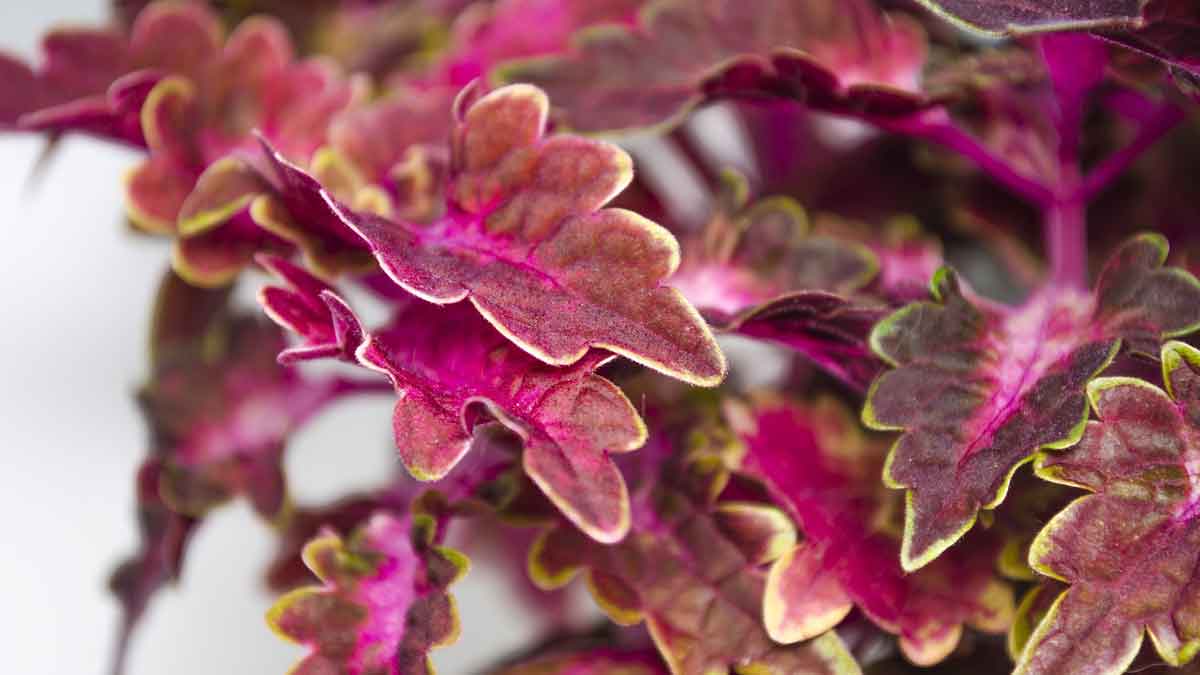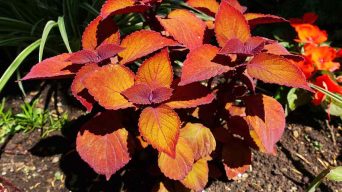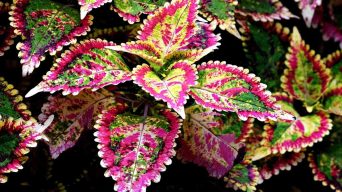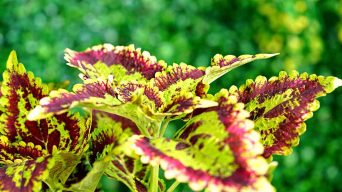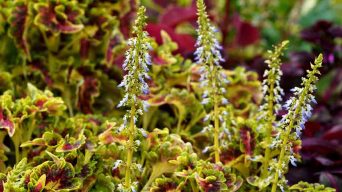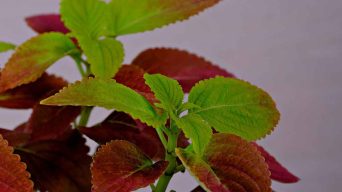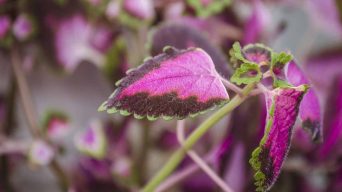Brown leaves on coleus plants can be caused by hot air, cool temperatures below 50F, overwatering, sun scorch, flooded soil, underwatering, extreme temperatures, or older leaves fading in color. Protect plants from extreme temps, water properly, avoid wetting leaves, and water soil directly to avoid these issues.
Are coleus leaves turning brown in your garden? If so, you’re not the only one experiencing this problem.
Browning coleus is a frequent challenge that arises from several different issues.
However, it can easily be fixed with the right knowledge and care.
In this guide, we’ll explain the typical causes of coleus leaves turning brown and how to treat them and prevent them from happening again.
Causes of Browning Leaves in Coleus Plants
Coleus plants are subject to numerous environmental factors affecting their growth and health.
Here are some of the most common reasons coleus leaves turn brown:
Exposure to Hot Air
One of the most common causes of coleus leaves turning brown is exposure to hot air from a heater or air conditioner.
Hot, dry air can cause coleus leaves to turn brown and crispy at the edges.
To protect your coleus plants from this type of damage, increase the humidity in the room by placing a humidifier in the same area as the coleus plants.
It is also important to avoid placing coleus plants directly near an air conditioning or heating vent, which can dry out coleus leaves and cause them to turn brown.
If you live in a hot climate, it may be beneficial to keep coleus plants indoors where they can stay cooler and more humid.
Cool Temperatures
Coleus leaves may turn brown or yellow when exposed to temperatures that are too cool.
If you live in a cooler climate, coleus plants should be moved indoors and away from cold drafts during winter.
For those living in an area with mild winters, coleus can remain outdoors as long as temperatures stay above freezing.
Cover coleus plants with a sheet or light blanket if left outside overnight.
Pruning coleus plants every now and then will help them stay compact, allowing for better protection from the cold.
If coleus leaves are already brown or yellowing due to cool temperatures, you can trim off the affected areas and give the plant more indirect light to promote new growth.
Overwatering
When coleus leaves turn brown, overwatering is often the culprit. Overwatering can cause coleus plants to suffer from root rot, which in turn causes coleus leaves to turn yellow and then become brown.
To prevent this from happening, it’s important to give coleus plants enough water but not too much.
The best way to do this is to check the soil before watering; if it’s still wet, wait a few days before giving the coleus plants more water. If the soil is dry, it’s time to water your coleus plant.
It’s also important to make sure coleus plants are planted in well-draining soil and have adequate drainage holes in their pots. This will help to reduce the risk of coleus plants being overwatered.
Extreme Temperature Changes
Coleus plants are sensitive to extreme changes in temperature.
If coleus leaves suddenly turn brown, a drastic change in temperature has likely occurred. This can include sudden drops in temperature or long periods of exposure to extreme heat.
Such changes can cause coleus leaves to turn brown, but the damage might not be permanent.
If the coleus plant is moved back into more stable temperatures, it may recover and return to its original color.
Keeping coleus plants away from extreme temperature changes is the best way to prevent coleus leaves from turning brown.
If coleus plants are placed near air conditioners, furnaces, fireplaces, or other sources of extremely hot or cold temperatures, they should be moved to a more suitable location.
Underwatering
Underwatering is a common cause of coleus leaves turning brown. It’s important to ensure your coleus plant gets enough water, especially when conditions are hot and dry.
Coleus plants should generally be watered when the top inch or two of the soil is dry. If the coleus leaves are turning brown, it’s important to water the plant more regularly.
In addition, adding a layer of mulch around the coleus plant can help retain moisture in the soil and prevent underwatering.
Overfertilizing
Coleus plants can get fertilizer burn if they’re overfertilized. They need a small amount of fertilizer to stay healthy, but too much will result in coleus leaves turning brown.
When a coleus plant is exposed to too much fertilizer, the roots cannot take up the nutrients they need. This causes coleus leaves to become discolored and die off. To avoid this, make sure to only fertilize once or twice a year during the growing season.
Use a balanced fertilizer at the lowest recommended rate and water your coleus thoroughly after fertilizing.
If coleus leaves are already turning brown due to overfertilization, flush the soil with clean water. This will help remove some of the excess fertilizer and give your coleus a chance to recover.
Sun Scorch
Coleus plants are often affected by sun scorch, which can cause coleus leaves to develop brown spots.
Sun scorch is caused when coleus plants are exposed to too much direct sunlight for long periods of time.
The sun’s rays can cause coleus leaves to become dry and brittle, leading to brown or yellow spots on the leaves and even coleus leaf death.
If your coleus plant has been affected by sun scorch, you should move it to a shadier area where it can get some relief from the sun.
You may need to prune off any dead or damaged leaves and provide additional water to help the coleus recover.
Lack of Humidity
Coleus plants need a certain amount of humidity to thrive. Their leaves will turn brown if the air around them is too dry.
This could happen when coleus plants are kept indoors, in an environment with heated or cooled air, or if the coleus is placed outside in a windy spot.
To help coleus plants stay healthy, you should mist them regularly with a spray bottle.
To increase humidity, you can also place the coleus pot on top of a tray of pebbles filled with water.
Root and Stem Rot
Stem and root rot are common culprits behind coleus leaves turning brown.
It is a fungus that infects the roots and stems of plants, causing them to die off. This can happen if the soil is too wet or the plant has been overwatered.
To prevent root rot, make sure you are not overwatering your coleus and that the plant is not in standing water.
Using an appropriate potting mix and ensuring proper drainage can also help prevent root rot.
Fungal Disease
If your coleus leaves are turning brown, it could be caused by a fungal disease.
Brown or black spots on the leaves and stunting of the growth of new leaves indicate an infection.
Fungal diseases are spread by spores, often from soil or other infected plants.
To prevent the disease from spreading, cut back any affected leaves and discard them.
Treat the plant with a fungicide containing copper sulfate or chlorothalonil to stop the infection and protect against further growth.
It’s also important to water your coleus from the base of the plant instead of from above to keep its foliage dry. This will help prevent the spread of spores and stop any plant disease from taking hold.
Pest Infestation
Coleus leaves can turn brown when pest infestations occur. Common pests that will attack coleus plants include aphids, mites, and mealybugs.
To determine if a pest infestation is the cause of your coleus leaves turning brown, inspect the underside of the leaf for small insects or webs.
If you spot any bugs, use insecticidal soap to remove them. Regularly spraying the coleus with a neem oil solution can also help keep pests away.
It’s important to act quickly when dealing with pest infestations, as the brown leaves can spread to other parts of the plant if left untreated.
If you notice any signs of infestation, isolate your coleus from other plants and take steps to eliminate the pests immediately.
Treatment for Browning Leaves in Coleus Plants
If your coleus plant leaves have begun to turn brown, it’s important to take action quickly.
Browning leaves are an indication of stress in the plant, which can be caused by various factors.
The good news is that you can take steps to remedy your coleus and get it back into healthy condition.
- Identify the Cause: The first step is to identify the cause of the browning leaves. Too much direct sunlight, underwatering, overwatering, or temperature stress can cause browning leaves in coleus plants.
- Move the Plant: If your coleus is in too much direct sunlight, move it to an outdoor or indoors spot with partial shade. This will provide relief from the harsh sun and help restore its health.
- Provide Proper Temperature: If the temperature is too extreme, bring your plant indoors or to a cooler spot. Extreme temperatures can cause the leaves to brown.
- Adjust Watering Schedule: Check the soil moisture of your coleus plant. Overwatering can lead to brown leaves, while underwatering will also cause browning. If the soil is dry, water your coleus more often, and if it’s too wet, allow the soil to dry out between watering sessions.
- Improve Drainage: If you notice that the potting soil is staying wet for long periods of time, improve the drainage. Coleus plants prefer well-draining soil, so add some perlite or sand to improve the drainage.
- Check for Fungal Growth: Examine your plant for signs of fungal growth, such as white powdery spots on leaves. If you find any, cut off the affected leaves and treat the plant with a fungicide.
- Increase Humidity: Increasing the humidity around your plant is also beneficial. Place a humidifier near it or mist the coleus daily to raise the humidity level.
- Fertilize With Care: Too much fertilizer can cause browning leaves. If you choose to fertilize, do so sparingly and with a balanced fertilizer with equal parts of nitrogen, phosphorus, and potassium at half-strength.
- Prune Damaged Leaves: Remove any severely brown or wilted leaves. This will help the plant focus its energy on healthier leaves and encourage new growth.
- Repot If Necessary: If the roots of your coleus are overcrowded, repot it into a larger pot. This will allow for more growth and help prevent browning leaves due to lack of oxygen.
Final Thoughts
Growing coleus plants is a rewarding experience. With the right care and maintenance, coleus leaves can retain their vibrant colors for many years.
If your coleus leaves are turning brown, it’s important to identify and address the cause as quickly as possible.
By properly assessing the issue, you can determine what needs to be done to restore your coleus plants’ health.
With the right attention and care, you’ll soon have healthy and vibrant coleus plants once again.

